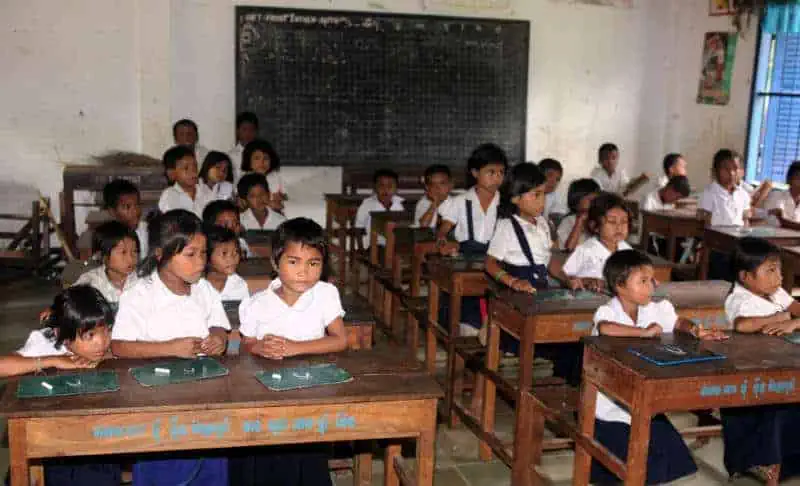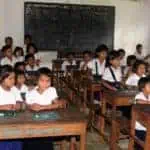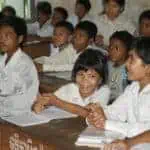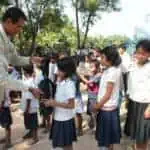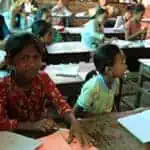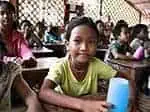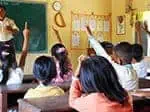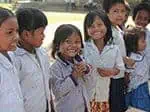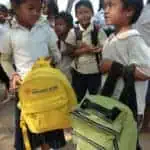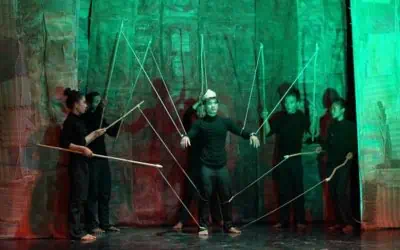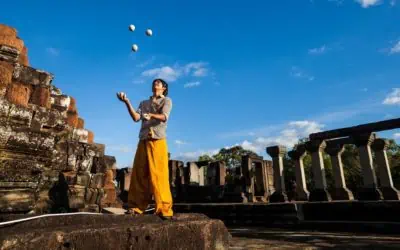Education in Cambodia
By Emily Martin
Education is the base for social and economic development of an individual, and a country.
“Education is the most powerful weapon which you can use to change the world.”
Nelson Mandela
In some parts of the world it is normal for school to be compulsory for all children over the age of 5, until they are in their teens. However in other parts of the world it is something that is harder to access – either because of the resources available or the country being in conflict.
So what is the picture of education in Cambodia?
Travelling through the country you will see hundreds of schools in the cities, the villages and the rural countryside. Cambodia has no shortage of schools. However, what there is a shortage of, is resources and teachers to fill these schools.
Sarah Pycroft, Project Manager at ABOUTAsia Schools says “education in Cambodia is meant to be free… but it’s not. The Government subsidy to schools per student, per year is as low as $1.75 according to our own research. Because of this teachers are paid next to nothing, forcing them to charge students for this and that.”
“They will only teach about half the curriculum in the Government allotted hours and then they’ll teach the other portion that the students need in private classes. This means that the students have to pay so the teachers can substitute their other income and so education becomes too expensive for many students.”
Because of this education is not readily available to all children and the drop-out rates are huge. “It depends what statistics you look at but generally it’s about 92% of kids that enrol in primary school to start with… only about 35% of them finish primary school to progress to middle school and only 19% finish secondary school.”
Teacher training is also lagging in Cambodia – many of the rural primary school teachers have only one ‘qualification’ behind them… they finished primary school themselves.
The classroom sizes are, on average, 47 pupils for each teacher. Not only this but “you often have one teacher trying to teach 3 different classes at the same time… or you have 2 classes in one classroom and a board at either end. The teacher will write on one board, and while the students copy that she/he will rotate to the other board and write on that. The issue isn’t no classrooms, but rather not enough teachers.”
The style of teaching and education in Cambodia is very different to a Western way of education. “Khmer teachers tend to only write on a board as their way of delivering a lesson. The children are used to sitting down, in rows, looking at the board and repeating after the teacher… if teachers really want to see results and see what their students are taking in, they need to learn themselves what learning looks like. They have no concept of what the kids are learning or if they are learning at all because they just spout information to the class who then writes it down. There’s not even an option for the kids to be wrong.”
There are many organisations operating in Cambodia who are working on changing this image of education in Cambodia. ABOUTAsia Schools is one of them.
They have 5 programmes making a positive impact on the picture of education in Cambodia. They work mainly supporting Government schools through:
- Providing resources such as chalk, notebooks, pens, uniforms, water wells, toilets, bicycles and chalkboards to public schools. Also specialist equipment like brail paper and typewriters for schools focusing on education for children who are bind.
- FREE English classes, 50 of them that run every day and are taught by local Khmer teachers out in the rural areas of Siem Reap province. “We employ and train the teachers, we pay their salary, we provide all the workbooks, the curriculum and we have teacher training for them.”
- Teacher training academy – working at upskilling local teachers
- Trained volunteering – with a huge boom in volountorusim more and more people want to come and teach English in Cambodia. Many do not have the required qualifications and so ABOUTAsia has created a learning service approach where they educate volunteers about being conscience and understanding their role. They have a crash course on how to teach English and therefore can have a much more positive impact in the classroom.
- Community learning centre programme – “I asked lots of people… you were successful, you got to the end of your High school, how did you do it? What helped you? Was it the teachers? Was it the facilities? And they all kind of said oh close to my house there was a man and he had the government text books and you could pay 500 reil and you could read them. You could study yourselves so it didn’t matter if the teacher didn’t turn up. So we started these community learning centres. We’ve filled them with text books, craft activities, sports equipment and loads of books to read… it worked so well! Students come every day, we also have free English classes there and we just got a football coach who is going to start doing football coaching once a week.”
There are many good things happening in the education sector of Cambodia, many organisations and individual schools working towards a brighter future for the students of the country.
“There are some really good small schools with very good education coordinators that are set up and work well. There are also so many free English schools which are fantastic! Even if children can’t afford to go to public school they can still come to the English classes and not only learn a valuable skill that will help them get jobs, but have that experience of learning.”
Schools such as Tiny Tunes in Phnom Penh and Phare Ponleu Selpak are also providing quality education but also an added dimension of the arts, “using it as a way to inspire them to think, to be intrigued by things and be interested in wanting to learn, wanting to know.”
“Anything that is encouraging the kids to think about things and gets kids excited about life and seeing different possibilities for themselves is amazing!”
“I think so many people can get so inspired by all the projects going on and that in itself – inspire and making them want to be interested and intrigued is powerful.”
Read more about the work ABOUTAsia Schools does and about the Responsible Tourism Travel Company that funds their work.

